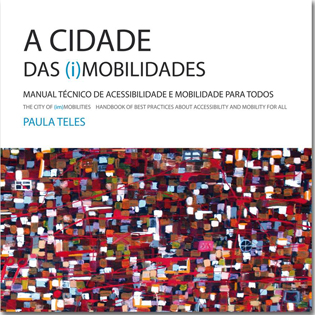Client. Mobilidade e Planeamento do Território
Project. THE CITY OF (im)MOBILITIES Handbook of Best Practices about Accessibility and Mobility for All
Year. 2014
Description. 
Every citizen has a territory that needs to be lived, suitable and shared, and Urban Mobility is considered the dimension of every individual's universe, that moment when everyday geographies are transcended, and new times and imaginaries are reinvented and designed.
Borja, Ascher, Castells, O’Nel.lo or Ribeiro da Silva stated that to be mobile is the amazing ability to think our urban condition beyond its physical aspect, as an immense social construction.
Therefore, this publication was though to contribute to this social construction, beyond the purely engineering, planning or architecture aspects.
Although essentially technical, this book bears several social, sociological and even political reflections. Despite being a handbook of best practices and notes for the urban design, the political dimension is present to state that everyone must have the same right to access the goods that a city has to offer.
This was the vitamin that nourished my everyday enthusiasm, regardless of the functions I might had, I have always tried to structure my activities with this huge sense of militancy.
This handbook was born from the social role of the engineer, architect or territory planner, and systematizes the experience of more than ten years working with this social duty in mind in every function.
It intends to provide solutions to the deficit of systematized and technical information, and also be a continuous study of the evolution of the paradigms relating to mobility conditions or its absence in most cities. It will also serve as a stimulus to young people who now begin their professional careers, by providing a non-traditional approach, sometimes not even taught at universities. An interesting guide for those who never heard of inclusive cities, and for those who are curious and active participants in civil society. I hope it can raise the awareness of citizens in general, technicians, entrepreneurs, managers, and of course, politicians.
Moreover, if at a first approach this publication presents itself essentially technique, the truth is that by reading Part 1, where the concepts and paradigms are presented chronologically and in a simple way, the reader will be quickly involved in a narrative filled with social and cultural paradigms inherent to this theme, but essentially he will be driven by the political force present in those contents.
Moving to Part 2, it is substantially technical and of great relevance for those who design cities, but then, in the last part of the book, although also essentially technical, it shows again a strong political content that demonstrate that those concepts are possible to implement. After all, with determination and political decision, as the example of the two case studies, it is possible to make interventions in public space and build for All, without losing the possibilities of being works of engineering or architecture of national or international reference. In other words, this work can simultaneously be an aesthetic challenge without giving up functionality.
The City Councils have been the key to this whole process, a growth that has been done gradually, though in a limited period of time, which sometimes has brought some problems. Judging by the interest and enthusiasm demonstrated in this regard, the Portuguese case has been a reference in Europe and even across the Atlantic, especially in Brazil, where we are giving now the first steps, successfully.
When it comes to principles and values, we have experienced anxiety, courage and persistence, but also love for this work, responsibility and passion, which are the best words to describe our will to improve our knowledge in this matter, which deserves to be shared at all levels.
Finally, I dedicate this book to my team in mpt, which shared with me these 10 years with enthusiasm, professionalism and loyalty to our customers, mostly Municipalities of Portugal that have trusted us and our work.
Thanks to all of you, I wish this book can be the expression, as in the words of Eduardo Lourenço, of a way of being in a territory of people wondering and wanting to be in the future by anticipating it.